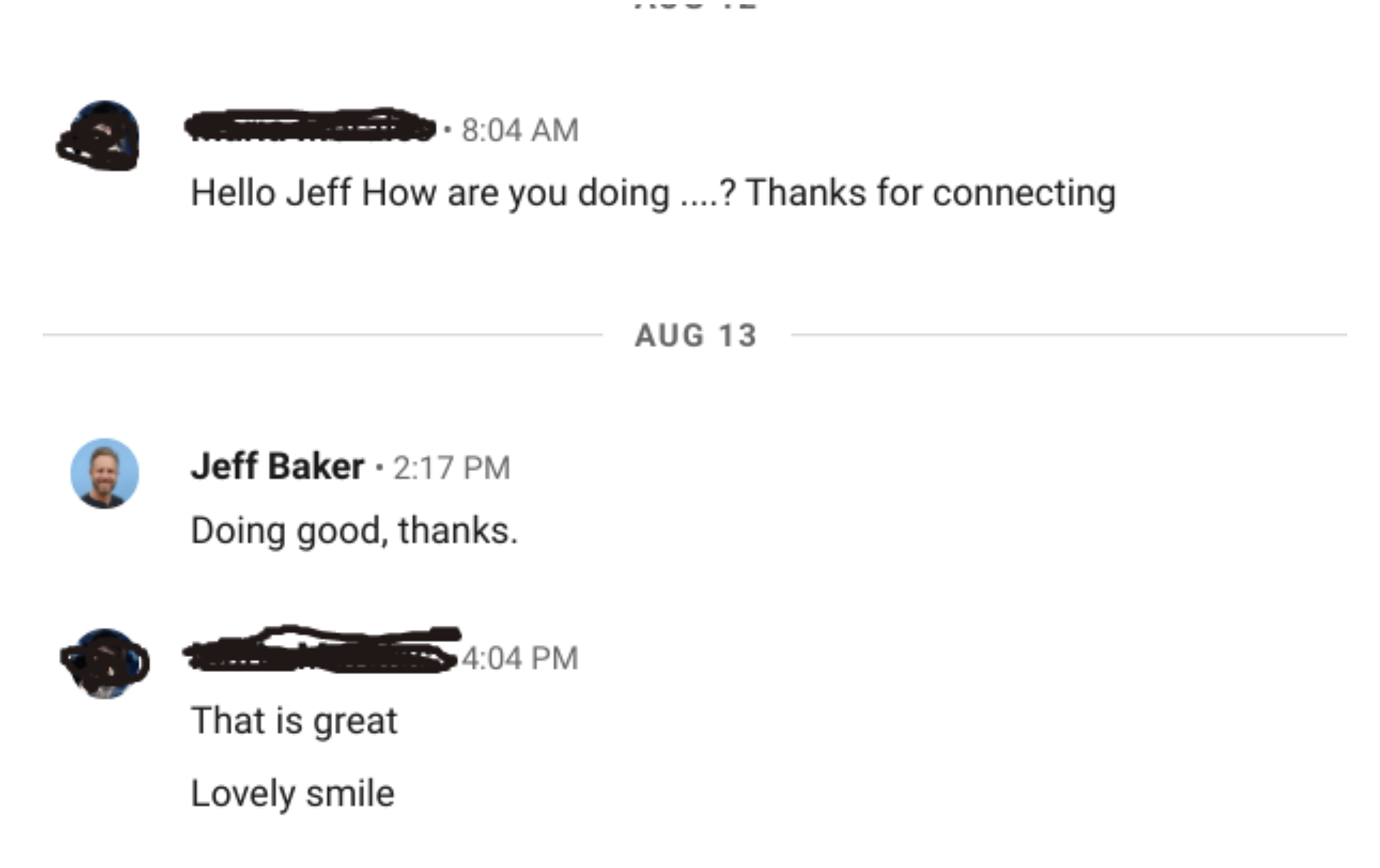I don’t mind if you try to pitch me crap I don’t need.
I really don’t.
Even if it’s completely cold and unsolicited, you have a job to do, and I sympathize.
But when you’re blatantly disingenuous with your salesy intentions, you insult my intelligence. And that’s when we have a problem.
What it looks like
It always starts with an invitation with an attached note that’s meant to put your guard down.
 How flattering, I’m a guru!
How flattering, I’m a guru!
I don’t know anyone who goes around sending private messages to strangers calling them “gurus”… but you’ve certainly done your best job to pump up my ego while turning off my mental spam shield.
Only, I know all-too-well that this is coming next…

I guess he didn’t care about my guru-ship after all, my poor ego! I almost got sweet-talked right into the bedroom 🙁
Only, I didn’t. Because I got 20 identical messages that week, and his true intentions were painfully transparent.
I’m going to go through the four most common pitch scenarios I regularly see, explain why they don’t work, and propose an alternative pitch.
I’m hoping this will both help the poor recipients identify the trap they are about to fall into, and give sales people alternative techniques that aren’t so painfully transparent.
Let’s dig in …
1. Lying about your intentions
There’s a reason people avoid car sales people like the plague: They don’t like being manipulated into buying something they don’t want or need.
LinkedIn sales people know this, so they use specific words that are meant to lower your guard. They’re meant to make you feel safe so that you don’t have to ready yourself against sales tactics.
Here are some of those “foot-in-the-door” phrases you’ll run into on LinkedIn, and what they actually mean:
| Statement | Actual Meaning |
| “I wanted to see if there were opportunities to collaborate” | “I want to give you a demo of our product” |
| “It seems we have mutual connections, so I thought it would make sense to connect” | “I’m trying to get my foot in the door so that I can pitch you after you accept” |
| “I wanted to explore mutual synergies” | “Synergies = you hand me money and I hand you a product” |
| “I’m interested in what Brafton is working on right now” | “Help me sell you” |
The main problem with these approaches is that sales people lose all of their credibility the second you find out they were lying, then the guard comes all the way up and never goes back down.
Look at the following approach and ask yourself if you feel put off:
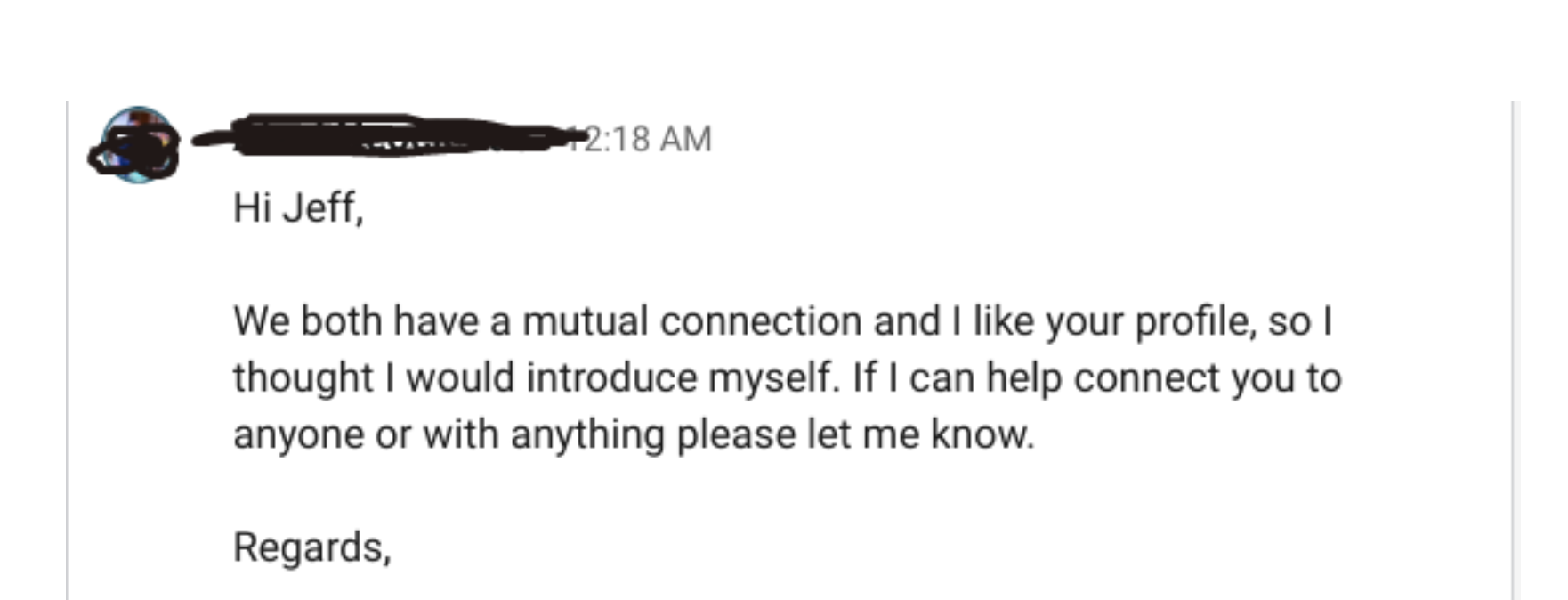
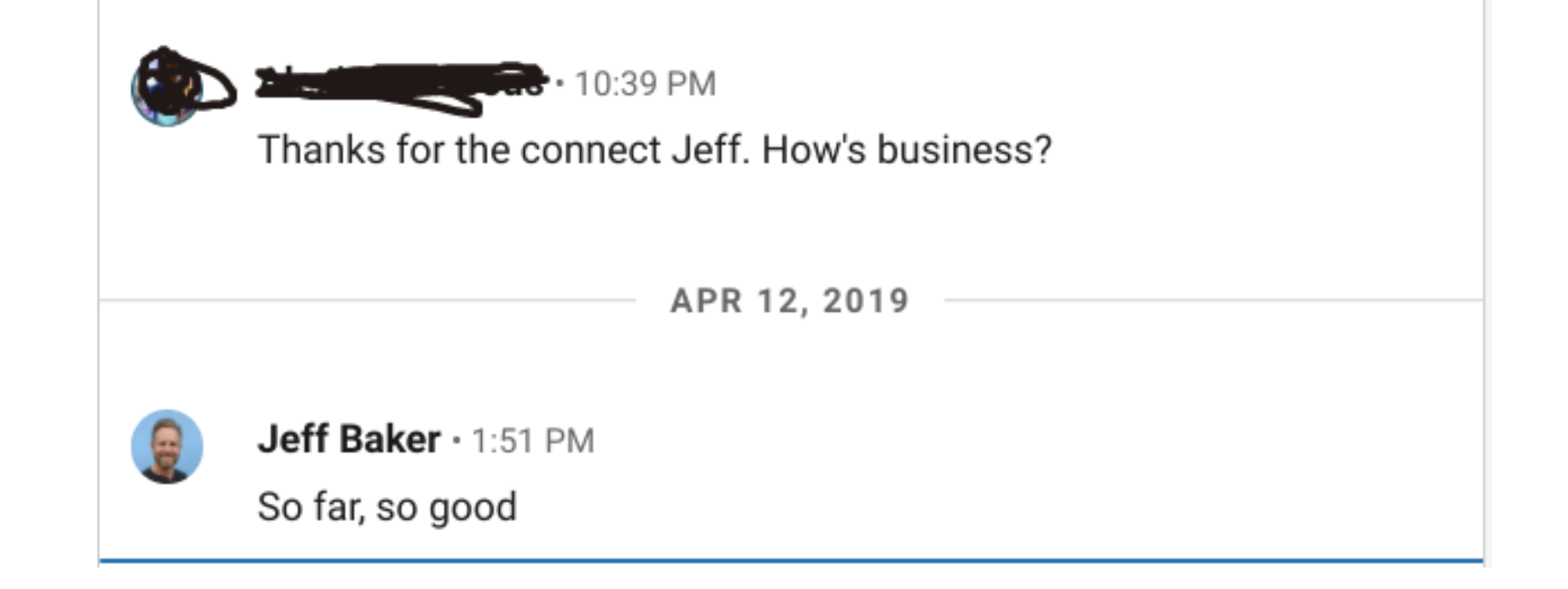
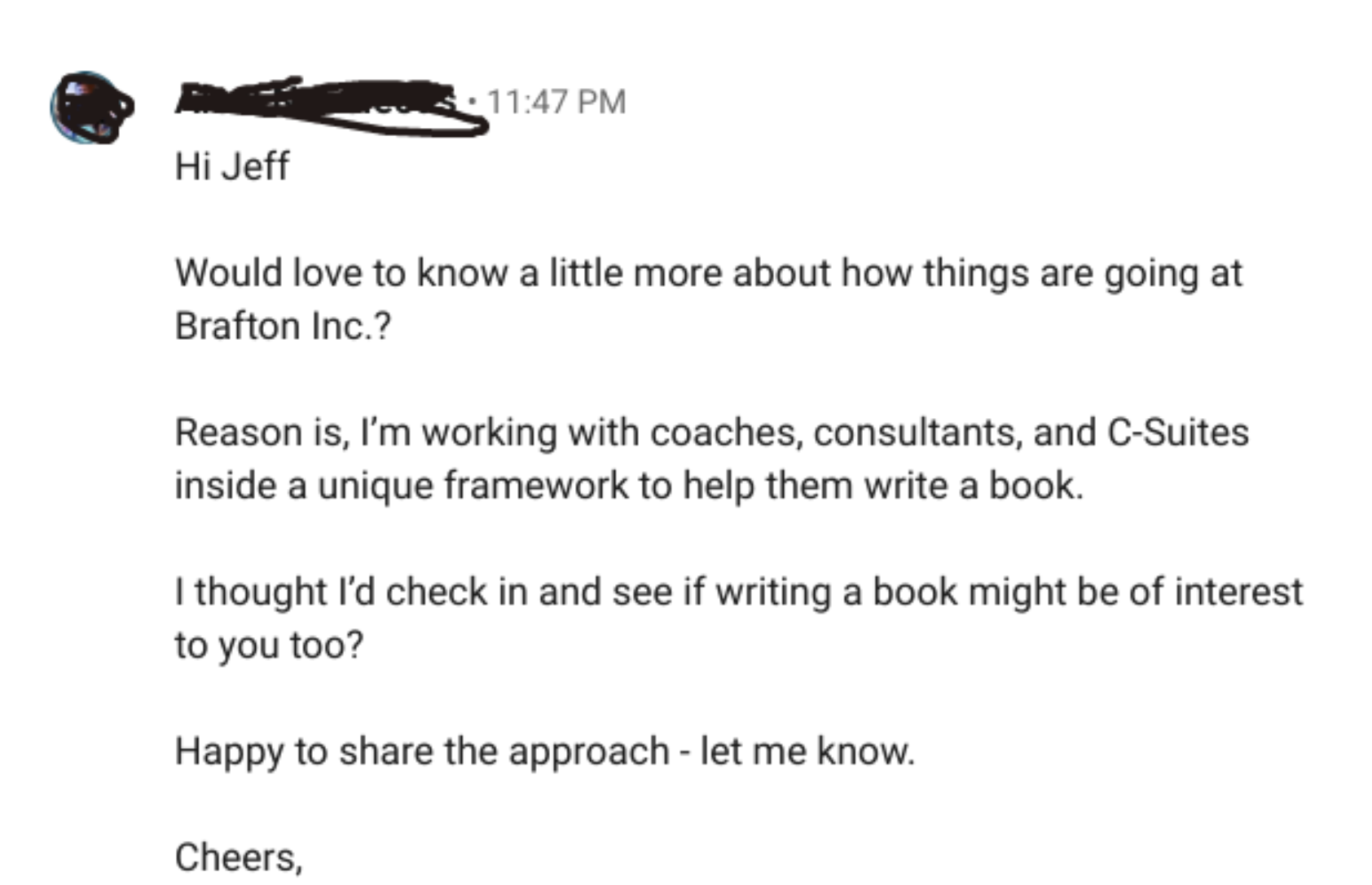
What gets me is the multiple-message song and dance that we have to go through before the sender actually reveals the real reason they messaged. It’s like really bad small talk prior to addressing the elephant in the room.
Here’s an alternative approach:
“Hey Jeff. I’m a complete stranger, so I’m not going to pretend that I messaged you for any other reason than to sell you something. With that out of the way, I’m going to give you a 30-second summary of what I’m selling and its features.
After reading, if you find that it’s something you’re interested in, you can respond back and I’ll give you some more details including pricing. If not, go ahead and ignore.
[Insert summary here]
Thanks for your time either way.”
Why this works: In reality, we shoppers want to do 90% of the research on our own, then tag in a salesperson when we need clarification about features, pricing and customization.
Just like when you go car shopping, you don’t want anyone hovering over your shoulder making you nervous. Give me all the information that I can process on my own, then I’ll come find you when I’m ready.
2. Clunky acknowledgment of difficult times
I’m talking about the current pandemic, but this can equally apply to a recession, natural disaster or any other event that can bring difficult economic times.
Sales people (and marketers, actually) have to navigate a razor-thin window of how to tactfully acknowledge a serious situation, and keep their job by selling products and services.
The absolute worst thing you can do is insert a boilerplate statement on top of your pitch.
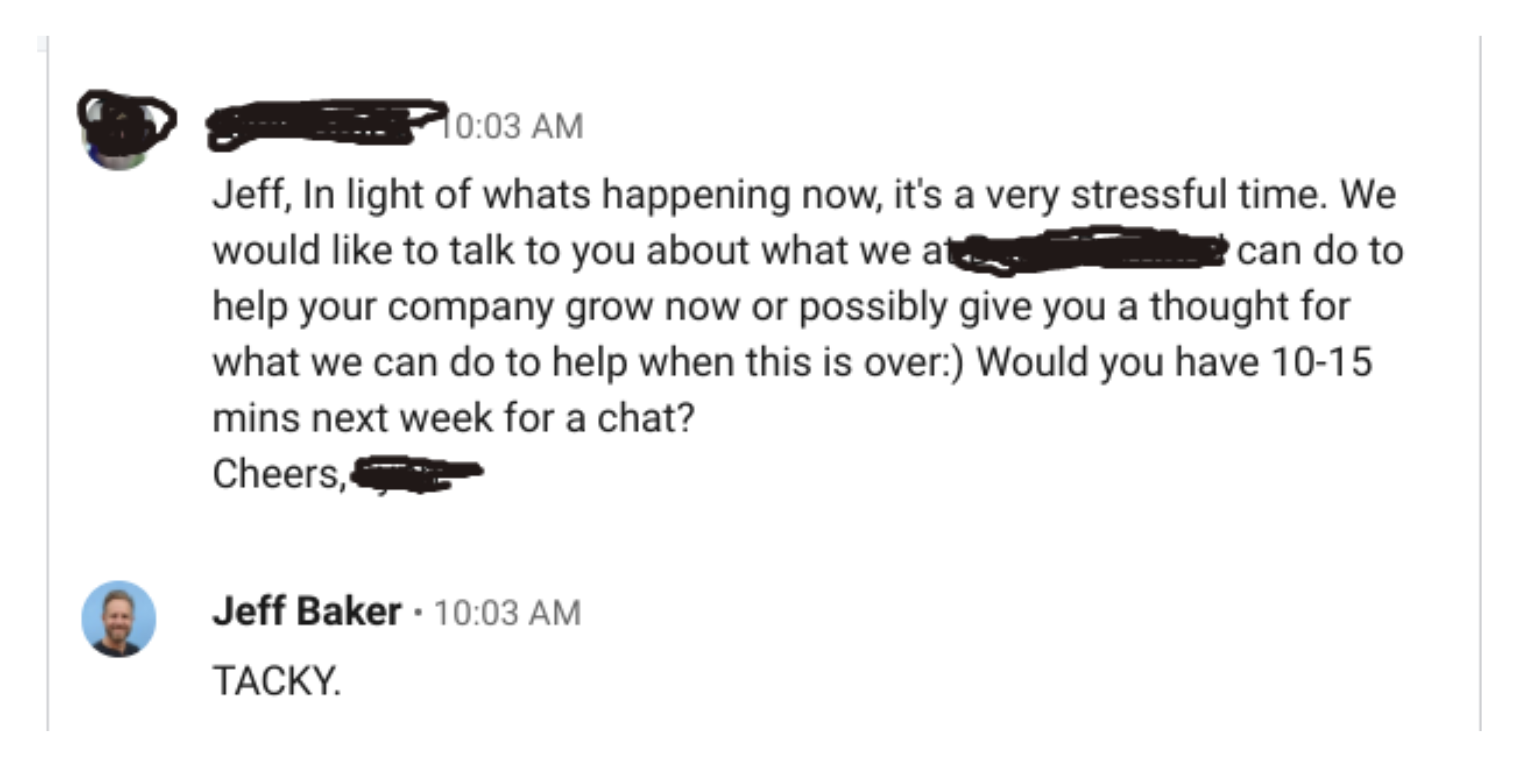
This one doesn’t work for so many reasons.
For starters, slapping “In light of what’s happening now, it’s a stressful time” in front of your pitch is sooooo disingenuous. You might as well say “I’m fulfilling my human empathy obligation.”
Second, it just reads so freaking clunky. If you’re going to feign empathy, at least spin a seamless story that doesn’t make me gag.
Here’s an alternative approach:
“Hey Jeff. I’m with a content marketing company. I’m sending you this note because most of our clients are in your industry, and they’ve asked us to completely change up our product offering to help them with the current situation.
They’re struggling to create daily email and social content to help their existing customers with their questions.
They don’t have the resources to keep up with what their customers need, so we’ve been helping them out. Here’s an example of what we’re doing.
[Insert Example]
If this is something we can help you and your customers with, let me know. Thanks.”
Pitching someone during a pandemic is never going to feel good. But, if you spend some time to figure out which customers actually need your services, and what those services are, you’ll find that you’re actually giving a customized pitch and product to people who actually need your service right now.
It’s sales, but it’s conscientious.
3. Preaching knowledge you’re not in a position to preach
I had someone cold pitch me a few months ago saying something along the lines of:
“Hi Jeff. First and foremost, safety is the most important thing. Stay home and save lives! It’s just not worth the risk, so make sure you prioritize lives first!”
So that’s good advice … from Anthony Fauci. But who the hell are you and when did I sign up for unsolicited preaching from a stranger?
The cold preacher also likes to drop industry knowledge bombs on me in an effort to try to convince me that I’ve missed a crucial detail. Here’s an example:

This one actually isn’t terrible, but doesn’t work nonetheless.
The problem is that using an uncited statistic to incite fear (I’m making a big mistake) immediately puts me on the defensive. I’m going to start thinking things you don’t want me to think, like:
“Where did you get that statistic?”
“How do you know anything about my business?”
“Is this salesperson really trying to educate me about something I do every single day?”
“This feels canned.”
And after that, you’ve lost me.
Here’s an alternative approach:
- Be humble and don’t assume you know more than the recipient.
- Cite your statistics – or even better – do your own original research.
- Make sure it’s hyper-relevant to the recipient.
Here’s an idea that could work:
“Hey Jeff. I just finished a massive content marketing research project and found something you might find interesting.
My research showed that infographics for B2C businesses like yours generate 323% more inbound links than any other type of content.
I sent this note to you specifically because I dug around your site a bit and found that you’ve created a couple infographics in the past. Those two infographics generated 10x more links than your top 100 blogs combined!
Considering you’ve only created a couple graphics, I thought you might be interested in taking a look at some of the graphics we create and see some pricing for outsourcing to us.
Let me know if you are interested, and thanks for reading.”
This type of approach is more labor-intensive, but would probably yield a higher response rate than throwing random stats at someone and acting like you know more about their industry than they do.
4. Having “sales” or jargony words in your LinkedIn title
Sorry to do this to you, but any time I catch a whiff of a sales title, I’ll decline your request. Even the cleverly disguised titles are pretty transparent.
Here’s some of the titles or headlines I can guarantee I won’t accept a connection for:
- “Business development [anything].”
- “Growth [anything].”
- “Sales.”
- “Hacking [anything].”
- “Storyteller.”
- “Helping businesses [fill in the blank].”
- “Ninja of [anything].”
- “Guru of [anything].”
- “Alchemist.”
- “Synergies [anywhere in your headline].”
I don’t know where these horrible headlines and titles come from (especially “alchemist” – are we in the 15th century?), but to me they all mean you’re going to sell me something.
Here’s an alternative approach:
If you want me to accept your invitation, I’d recommend changing your LinkedIn title or headline to any of the following:
- “Consultant of [fill in the blank].”
- “Strategist of [fill in the blank].”
- “Analyst of [fill in the blank].”
- “Specialist of [fill in the blank].”
You can still effectively sell me without your actual title or cheeky headline. The only difference is that I won’t shut the door on your foot.
Closing rules of thumb
If there is a theme to take away from this post, it’s that you need to always customize your approach and be as genuine as possible. The LinkedIn sales pitch strategy is fully mature. Anyone on the platform knows all the tricks and we have our mental spam blockers activated.
If you’re doing this right, it should take a lot longer to come up with a well-thought out message that’s customized to your recipient. It may take five times as long, but would you prefer a response rate of 1:100 messages sent … or 5:20 messages sent?
Like I said, I don’t mind if you pitch me crap I don’t need. People gotta eat, and I appreciate the hustle. But hustle with integrity.
Oh and lastly, let’s try to keep it professional, people. This isn’t a dating platform (yet).
